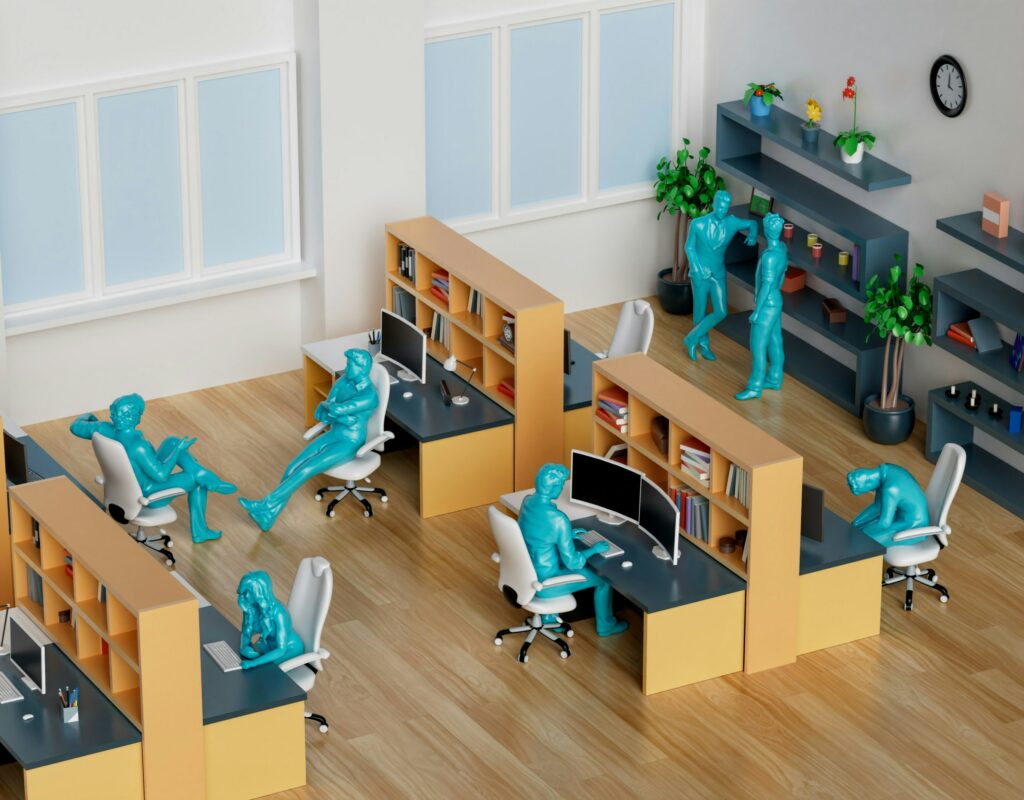
Hot desks have become a crucial strategy for organisations aiming to optimise space, promote collaboration, and increase flexibility. This modern approach maximises office space and encourages teamwork and adaptability, resulting in a more dynamic and efficient work environment. However, successful implementation requires more than just rearranging furniture; it demands clear communication, thoughtful design, technological integration, and a deep understanding of employee needs. Let’s explore the essential steps for creating a thriving hot desk environment and how communication, design, and technology can drive this transformation.
Organisational changes, like implementing hot desks, can be challenging for employees. Clear and transparent communication about why hot desks are being adopted is vital to gain employee support and ensure a smooth transition. Employees should understand the strategic goals behind hot desks, whether it’s to better use space, encourage collaboration, or increase flexibility. Explaining how hot desks fit into the organisation’s broader objectives can give employees a sense of purpose and clarity.
Additionally, providing comprehensive training is crucial. Training should go beyond operational instructions and cover the principles of hot desks, highlighting the benefits for individual productivity, team dynamics, and overall performance. During training, addressing common concerns, such as privacy and workspace availability, can help alleviate employee anxieties. Continuous support after implementation ensures employees feel confident and capable of navigating the new hot desk system.
The success of hot desks depends on creating diverse work environments that cater to different work styles and preferences. Incorporating a variety of settings, such as open collaboration areas, quiet zones for focused work, and breakout spaces for informal meetings, is essential. This variety allows employees to choose the environment that best suits their tasks and preferences at any given time.
Thoughtful design elements, such as ergonomic furniture, ample natural light, and greenery, can enhance the functionality and appeal of these spaces. Providing collaborative and solitary work options helps employees balance interaction and concentration, fostering a more productive work environment. Leveraging technology to ensure seamless connectivity and access to resources across different work areas further enhances the user experience and facilitates smooth collaboration.
Advanced technology is crucial for the smooth operation of a hot desk environment. Implementing a reliable desk booking system with user-friendly features allows employees to easily reserve workspaces, making the transition to hot desks smoother. The system should offer real-time updates on workspace availability, colleague search functions, customisable preferences, and integration with other organisational tools like Microsoft 365.
Investing in robust IT infrastructure is also essential. This includes ensuring reliable network connectivity, efficient hardware and software solutions, and robust cybersecurity measures to protect sensitive data. Providing comprehensive IT support, including helpdesk services and technical troubleshooting, is vital for addressing any technical issues and minimising disruptions.
Regular training sessions and resources to help employees use technology effectively within the hot desk framework can empower them to make the most of digital tools and optimise their workflow. Organisations can create an integrated hot desk ecosystem that boosts collaboration, productivity, and employee satisfaction by prioritising technological innovation and user-friendly design.
Balancing collaboration and individual privacy is key to successful hot desks. Creating specific areas for collaborative activities, such as team meetings and brainstorming sessions, encourages teamwork and idea exchange. These areas should have collaborative tools like whiteboards and comfortable seating to support productive interactions.
At the same time, providing quiet zones or secluded spaces for focused work is essential. These areas should minimise noise and visual distractions to create an environment conducive to concentration. Soundproofing, privacy screens, and adjustable lighting can enhance these spaces, making them ideal for individual tasks.
Allowing employees to choose their workspace based on their current needs, whether for collaboration or focused work, promotes a dynamic and inclusive work culture. By balancing collaboration and privacy, organisations can foster creativity, productivity, and employee well-being.
Offering storage solutions for personal belongings is important to maintain an organised and secure workplace. Tailoring storage solutions to the office layout and design optimises space utilisation. Lockers of various sizes can provide individualised storage, offering convenience and peace of mind. Designated storage areas with shelves, cabinets, or cubbies ensure easy access and organisation of personal items. Secure cabinets or drawers with locks add an extra layer of security, giving employees confidence that their belongings are safe and contributing to a comfortable work environment.
Establishing a feedback loop is crucial for the ongoing success of the hot desk environment. Regularly collecting employee feedback on their hot desk experiences shows a commitment to their well-being and satisfaction. Encourage open communication through surveys, suggestion boxes, or focus groups where employees can share their thoughts and suggestions. Actively listen to their feedback, noting both positive experiences and areas needing improvement. Analysing this feedback can help identify patterns and inform decision-making.
Being open to constructive criticism and adjusting based on employee input ensures continuous improvement. Feedback should be used to refine the hot desk model to better align with organisational needs and employee preferences.
Transitioning to hot desks is an ongoing process of refinement and adaptation. Organisations can create a dynamic workplace culture that promotes productivity, innovation, and employee satisfaction by fostering open communication and designing versatile work environments. Embracing feedback as a tool for continuous improvement ensures that the hot desk environment evolves with the organisation’s needs and employee preferences, fostering a more agile and resilient workplace for the future.
Discover the benefits and challenges of hot desking by clicking the button below.
Subscribe to the monthly newsletter!
By clicking the “Subscribe” button above, you agree to the Terms & Conditions and Privacy Policy
2014 – 2024 Proudly designed and made in Lithuania
Over 60,000 users worldwide can’t be wrong – see for yourself why they choose TableAir.